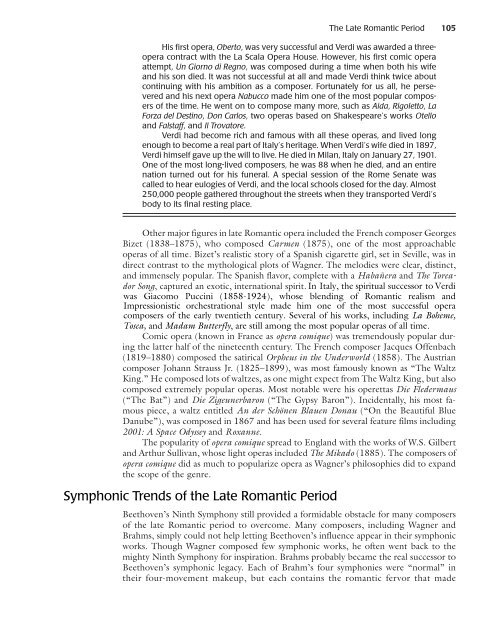Composer Profile - Activefolio
Composer Profile - Activefolio
Composer Profile - Activefolio
You also want an ePaper? Increase the reach of your titles
YUMPU automatically turns print PDFs into web optimized ePapers that Google loves.
The Late Romantic Period 105<br />
His first opera, Oberto, was very successful and Verdi was awarded a threeopera<br />
contract with the La Scala Opera House. However, his first comic opera<br />
attempt, Un Giorno di Regno, was composed during a time when both his wife<br />
and his son died. It was not successful at all and made Verdi think twice about<br />
continuing with his ambition as a composer. Fortunately for us all, he persevered<br />
and his next opera Nabucco made him one of the most popular composers<br />
of the time. He went on to compose many more, such as Aida, Rigoletto, La<br />
Forza del Destino, Don Carlos, two operas based on Shakespeare’s works Otello<br />
and Falstaff, and Il Trovatore.<br />
Verdi had become rich and famous with all these operas, and lived long<br />
enough to become a real part of Italy’s heritage. When Verdi’s wife died in 1897,<br />
Verdi himself gave up the will to live. He died in Milan, Italy on January 27, 1901.<br />
One of the most long-lived composers, he was 88 when he died, and an entire<br />
nation turned out for his funeral. A special session of the Rome Senate was<br />
called to hear eulogies of Verdi, and the local schools closed for the day. Almost<br />
250,000 people gathered throughout the streets when they transported Verdi’s<br />
body to its final resting place.<br />
Other major figures in late Romantic opera included the French composer Georges<br />
Bizet (1838–1875), who composed Carmen (1875), one of the most approachable<br />
operas of all time. Bizet’s realistic story of a Spanish cigarette girl, set in Seville, was in<br />
direct contrast to the mythological plots of Wagner. The melodies were clear, distinct,<br />
and immensely popular. The Spanish flavor, complete with a Habañera and The Toreador<br />
Song, captured an exotic, international spirit. In Italy, the spiritual successor to Verdi<br />
was Giacomo Puccini (1858-1924), whose blending of Romantic realism and<br />
Impressionistic orchestrational style made him one of the most successful opera<br />
composers of the early twentieth century. Several of his works, including La Boheme,<br />
Tosca, and Madam Butterfly, are still among the most popular operas of all time.<br />
Comic opera (known in France as opera comique) was tremendously popular during<br />
the latter half of the nineteenth century. The French composer Jacques Offenbach<br />
(1819–1880) composed the satirical Orpheus in the Underworld (1858). The Austrian<br />
composer Johann Strauss Jr. (1825–1899), was most famously known as “The Waltz<br />
King.” He composed lots of waltzes, as one might expect from The Waltz King, but also<br />
composed extremely popular operas. Most notable were his operettas Die Fledermaus<br />
(“The Bat”) and Die Zigeunerbaron (“The Gypsy Baron”). Incidentally, his most famous<br />
piece, a waltz entitled An der Schönen Blauen Donau (“On the Beautiful Blue<br />
Danube”), was composed in 1867 and has been used for several feature films including<br />
2001: A Space Odyssey and Roxanne.<br />
The popularity of opera comique spread to England with the works of W.S. Gilbert<br />
and Arthur Sullivan, whose light operas included The Mikado (1885). The composers of<br />
opera comique did as much to popularize opera as Wagner’s philosophies did to expand<br />
the scope of the genre.<br />
Symphonic Trends of the Late Romantic Period<br />
Beethoven’s Ninth Symphony still provided a formidable obstacle for many composers<br />
of the late Romantic period to overcome. Many composers, including Wagner and<br />
Brahms, simply could not help letting Beethoven’s influence appear in their symphonic<br />
works. Though Wagner composed few symphonic works, he often went back to the<br />
mighty Ninth Symphony for inspiration. Brahms probably became the real successor to<br />
Beethoven’s symphonic legacy. Each of Brahm’s four symphonies were “normal” in<br />
their four-movement makeup, but each contains the romantic fervor that made



